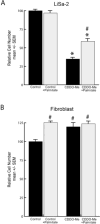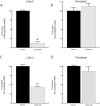Fatty acid synthesis is a therapeutic target in human liposarcoma
- PMID: 20372807
- PMCID: PMC3754849
- DOI: 10.3892/ijo_00000616
Fatty acid synthesis is a therapeutic target in human liposarcoma
Abstract
Liposarcomas (LS) are mesenchymal tumors that can recur after surgical resection and often do not respond to presently available medical therapies. This study demonstrates the dependence of LS on de novo long-chain fatty acid synthesis for growth. Lipogenesis can be impaired by inhibiting the activities of lipogenic enzymes, including acetyl CoA-carboxylase (ACC) and fatty acid synthase (FASN), or by suppressing the expression of key genes involved in the pathway and its regulation. The FASN inhibitors cerulenin and orlistat reduced the growth of two LS cell lines (LiSa2, SW872), as did inhibition of ACC with soraphen A. CDDO-Me, a synthetic triterpenoid, suppressed expression of Spot 14 and FASN genes and likewise inhibited LS cell growth. Importantly, the anti-proliferative effect of each agent was prevented by the co-administration of palmitate, the major product of cellular long-chain fatty acid synthesis. In stark contrast to LS cells, these compounds had no effect on the growth of fibroblasts. Four biochemically distinct agents that target critical points in the fatty acid synthetic pathway exert anti-proliferative effects on LS cells, and rescue of cell growth by palmitic acid suggests that reduced tumor cell lipogenesis mediates the growth inhibition. These findings warrant further studies aimed at the clinical exploitation of the dependence of LS cell growth on fatty acids.
Figures






Similar articles
-
The synthetic triterpenoid CDDO-Im inhibits fatty acid synthase expression and has antiproliferative and proapoptotic effects in human liposarcoma cells.Cancer Invest. 2008 Mar;26(2):118-27. doi: 10.1080/07357900701522612. Cancer Invest. 2008. PMID: 18259941 Free PMC article.
-
Effects of fatty acid synthase inhibitors on lymphatic vessels: an in vitro and in vivo study in a melanoma model.Lab Invest. 2017 Feb;97(2):194-206. doi: 10.1038/labinvest.2016.125. Epub 2016 Dec 5. Lab Invest. 2017. PMID: 27918556
-
Overexpression of fatty acid synthase in human gliomas correlates with the WHO tumor grade and inhibition with Orlistat reduces cell viability and triggers apoptosis.J Neurooncol. 2014 Jun;118(2):277-287. doi: 10.1007/s11060-014-1452-z. Epub 2014 May 1. J Neurooncol. 2014. PMID: 24789255
-
Pharmacological inhibitors of Fatty Acid Synthase (FASN)--catalyzed endogenous fatty acid biogenesis: a new family of anti-cancer agents?Curr Pharm Biotechnol. 2006 Dec;7(6):483-93. doi: 10.2174/138920106779116928. Curr Pharm Biotechnol. 2006. PMID: 17168665 Review.
-
The mitochondrial H(+)-ATP synthase and the lipogenic switch: new core components of metabolic reprogramming in induced pluripotent stem (iPS) cells.Cell Cycle. 2013 Jan 15;12(2):207-18. doi: 10.4161/cc.23352. Epub 2012 Jan 15. Cell Cycle. 2013. PMID: 23287468 Free PMC article. Review.
Cited by
-
Lipogenesis and lipolysis: the pathways exploited by the cancer cells to acquire fatty acids.Prog Lipid Res. 2013 Oct;52(4):585-9. doi: 10.1016/j.plipres.2013.08.005. Epub 2013 Aug 31. Prog Lipid Res. 2013. PMID: 24001676 Free PMC article. Review.
-
Synthetic oleanane triterpenoids: multifunctional drugs with a broad range of applications for prevention and treatment of chronic disease.Pharmacol Rev. 2012 Oct;64(4):972-1003. doi: 10.1124/pr.111.004846. Epub 2012 Sep 10. Pharmacol Rev. 2012. PMID: 22966038 Free PMC article. Review.
-
Proteomics of genetically engineered mouse mammary tumors identifies fatty acid metabolism members as potential predictive markers for cisplatin resistance.Mol Cell Proteomics. 2013 May;12(5):1319-34. doi: 10.1074/mcp.M112.024182. Epub 2013 Feb 8. Mol Cell Proteomics. 2013. PMID: 23397111 Free PMC article.
-
Lipids and cancer: Emerging roles in pathogenesis, diagnosis and therapeutic intervention.Adv Drug Deliv Rev. 2020;159:245-293. doi: 10.1016/j.addr.2020.07.013. Epub 2020 Jul 23. Adv Drug Deliv Rev. 2020. PMID: 32711004 Free PMC article. Review.
-
Differentiation of breast cancer stem cells by knockdown of CD44: promising differentiation therapy.J Transl Med. 2011 Dec 7;9:209. doi: 10.1186/1479-5876-9-209. J Transl Med. 2011. PMID: 22152097 Free PMC article.
References
-
- Mack T. Sarcomas and other malignancies of soft tissue, retroperotineum, peritoneum, pleura, heart, mediastinum, and spleen. Cancer. 1995;75:S211–S244. - PubMed
-
- Patel S, Burgess M, Plager C, Papadopoulos N, Linke K, Benjamin R. Myxoid liposarcoma: experience with chemotherapy. Cancer. 1994;74:1265–1269. - PubMed
-
- Baird K, Davis S, Antonescu C, et al. Gene expression profiling of human sarcomas: insights into sarcoma biology. Cancer Res. 2005;65:9226. - PubMed
-
- Menendez J, Lupu R. Fatty acid synthase and the lipogenic phenotype in cancer pathogenesis. Nat Rev Cancer. 2007;7:763–777. - PubMed
Publication types
MeSH terms
Substances
Grants and funding
LinkOut - more resources
Full Text Sources
Other Literature Sources
Miscellaneous

